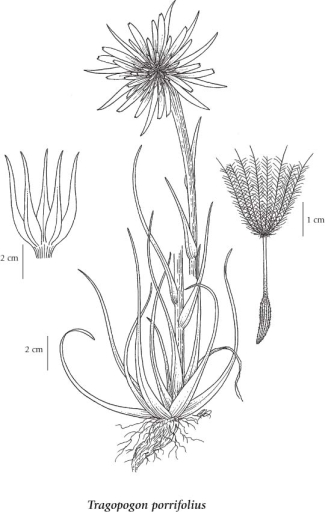common salsify (oyster plant; salsify)
Asteraceae (Aster family)
Introduction to Vascular Plants
Species Information
General:
Biennial herb from a taproot; stems erect, solitary, simple or more commonly branching from the base, glabrous, exuding milky juice when broken, 0.4-1 m tall.
Leaves:
Basal leaves lacking; stem leaves entire, grasslike, tapering uniformly from base to the apex, parallel-veined with clasping bases, 5-30 cm long, 0.5-2 cm wide.
Flowers:
Heads with strap-shaped flowers, solitary, on enlarged, hollow stalks terminating the stems or few branches; involucres 2.5-4 cm tall; involucral bracts lanceolate, swollen at the base, equal, 5-11 or more commonly about 8, barely to strongly surpassing the ray flowers; ray flowers purple; disk flowers lacking.
Fruits:
Achenes elongate, 5- to 10-ribbed, 2.5-7 cm long, tapering to the slender beak; pappus of brownish, slender-tipped, feathery bristles, the feathery branches interwebbed.
Illustration

If more than one illustration is available for a species (e.g., separate illustrations were provided for two subspecies) then links to the separate images will be provided below. Note that individual subspecies or varietal illustrations are not always available.
Illustration Source: The Illustrated Flora of British Columbia
USDA Species Characteristics
Flower Colour:
Purple
Blooming Period:
Mid Spring
Fruit/Seed characteristics:
Colour: Brown
Present from Spring to Summer
Source: The USDA
Habitat and Range
Dry roadsides and waste places in the lowland, steppe and montane zones; infrequent in SC BC, frequent in SW BC, known from Vancouver Island and the Gulf Islands; introduced from Europe.Status Information
Taxonomic Keys
1. Stalks of the heads cylindric, not enlarged above; outer ray flowers yellow, equal to or exceeding the involucral bracts.........................T. pratensis
1. Stalks of the heads enlarged above outer ray flowers yellow or purple, shorter than the involucral bracts. 2. Ray flowers purple; involucral bracts usually 8-9; leaves dilated and clasping at the base.........................T. porrifolius 2. Ray flowers yellow; involucral bracts usually 13; leaves generally tapering evenly from the base to the tips..............................T. dubius Source: Illustrated Flora of British Columbia |